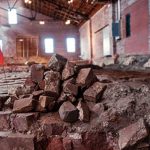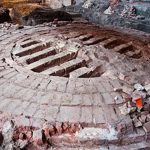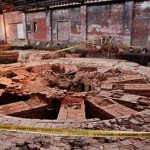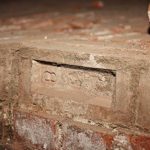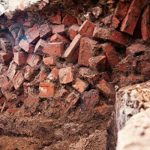The Dig
In 2010, an Industrial Archaeologist named Talva Jacobson came to the Historic Clay District to complete an archaeological study of Medalta’s Kiln Room.
The Discovery
Three round kilns, as well as a wealth of other archaeological information, was discovered under the concrete floor which was constructed sometime in the 1960’s.
Archaeological Study of Medalta’s Kiln Room
In 2010, an Industrial Archaeologist named Talva Jacobson came to the Historic Clay District to complete an archaeological study of Medalta’s Kiln Room. We were reasonably sure that the foundations of at least three round kilns were under the concrete floor which was constructed sometime in the 1960’s. As Talva and her team excavated, they were indeed able to find kiln foundations as well as a wealth of other archaeological information which will aid in understanding the processes of industry in the early years of the twentieth century.
The story of Medalta and the industrial clay boom in Medicine Hat represents the beginning of our community. But when we zoom out and talk about the pottery industry on a broader level, we find that this was actually the end of what Talva (and other Archaeologists, to be fair) calls Folk Pottery. And so I guess we have a bit of a paradox – Medicine Hat was actually founded on the tail end of a very dominant industry.
The term Folk Pottery needs a bit of clarification. In Talva’s thesis, she identifies two streams of ceramics: Fine Art on one hand, and Folk on the other. Folk Pottery doesn’t necessarily need to be small (Medalta is a Folk Pottery, for example) just as an Industrial Pottery doesn’t necessarily need to be big. Her interest with Medalta is in Folk Pottery, which was inexpensive and with a primary focus on utility.
Through the process of modernization, Folk Pottery Grew. See if you can spot where Medalta fits in.
People living in the Traditional stage started out creating simple ware for themselves and ended with the creation of a cottage industry, where they were creating ware for their immediate community. It’s kind of like making toques for your kids and eventually making enough to sell on Etsy.
The next step is when the industry takes off and pottery begins to exist as a product on its own, produced for profit. Phase three is when actually knowing how to be a potter isn’t all that important, strangely. Pottery has now become a business and those who wanted to make money creating pottery could hire someone who did know how.
The final stage is high mass consumption. Production now needs to be ramped up to a pretty massive scale to meet demand, which needs pretty big manufacturing plants to sustain it.
Of course, with the emergence of these factories, the skill required was reduced. Processes were generally automated (keeping in mind that our vision today of automation includes less wooden wheels. But the concept was generally the same), tasks were separated so that the person mixing the clay probably couldn’t make a pot and the one making the pot probably didn’t know too much about firing.
It’s a lot like the emergence of Wal-Mart and the big-box consumer movement that we’re currently in the middle of. For better or worse, it has been argued that this style of retail came at the expense of local retailers in our communities’ downtowns. Just as traditional potters were replaced by mass-production facilities.
Of course, as we all know, folk pottery has come a long way down from its apex at the turn of the 20th Century. And the reason the pottery industry is talked about today with such a nostalgic air is that it was once an empire of sorts. It seems that has been forgotten, perhaps because pottery’s relevance in our day-to-day lives is less obvious than in decades past.
We always had a strong hunch that Medicine Hat was tied to this history. We just didn’t have much evidence. This dig will solve a lot of puzzles.





